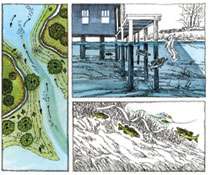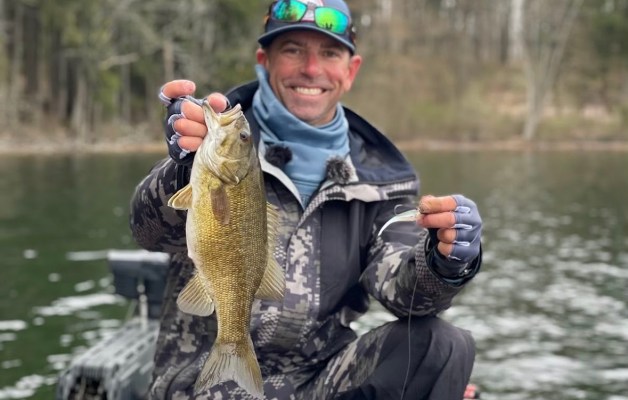
It can almost be like a whisper. The night temperature drops a couple of degrees. Length of daylight grows a few minutes shorter. A cool front blows through with a slightly different feel, a hint that summer is waning and fall is at hand. This change may be nearly imperceptible to bass anglers, but the fish they seek feel it, and they react instinctively to get ready for the cold months ahead.
The shad move first, migrating from deep, main lake areas into tributary creeks, and bass follow these baitfish. Deep water concentrations of bass begin breaking down in late summer/early fall.
"During this transition time, when the fish are between their summer holding areas and the flats back in the creeks, they can be difficult to find," says James Niggemeyer of Van, Texas. "This usually occurs from late August into October. You know this transition is happening when your good summer spots suddenly quit producing."
Niggemeyer, a BASS Elite Series pro angler, guided for five years on Texas' Lake Fork before hitting the tourney trail full time. One day in early September, he and a friend were fishing deep holes on Fork, and bites were few and far between. "The fish just weren't where they had been, so we started moving and checking different spots to try to relocate them."
The two anglers stumbled onto a pattern that was red hot, producing a 7-pounder, a 6-pounder and several in the 4- and 5-pound range. It also became their blueprint for finding bass in other lakes when the transition to fall is under way.
Niggemeyer explains, "We found these fish holding next to standing pole timber on long points and creek channel banks close to where the bass had been hanging out in summer, but on shallower structure. In other words, they had started moving toward the backs of the creeks, and these were the first places they'd stopped. They were holding around the trees and waiting for baitfish to come swimming by."
Niggemeyer continues that since he discovered this pattern, it has stood the test on other lakes. "There might not be pole timber in a given lake, but when they start moving, the bass will orient to whatever cover is available on these transition areas. I've found them on boat docks close to channels leading back into creeks. I've found them on submerged points and channel swings, especially where there are stumps, rocks, grass, brushpiles or other cover present.
"The point is, you've got to get this 'in-between' mind-set. You've got to get in between where the bass were and where they're going, and then you simply test different options in this zone until you find the fish."
When he starts his search, Niggemeyer targets the mouth and lower third of major creek embayments. "I'm typically looking for fish in the 6- to 15-foot zone (depending on water clarity), and it's important to have deep water close by. When the bass make their first move, it's usually to the best midlevel structure or cover closest to where they spent the summer. Then they'll migrate progressively farther back into the creek as more cold fronts blow through and the water temperature continues dropping."
Niggemeyer tailors his fishing methods to the type of structure/cover he's targeting. "On that pole timber, my buddy and I caught our fish on 4-inch finesse worms rigged Texas-style on Strike King Shaky Head jigheads. The trees were in 12 to 15 feet of water, and the bass were holding around the trunks and under horizontal limbs 3 to 4 feet beneath the surface. We'd make short pitches to limbs we could barely see and let the bait fall beside the cover. The fish would grab it on the way down."
(See Tackle Tricks sidebar for more detailed instructions on this technique.)
Niggemeyer uses the same bait/method around boat docks, especially those built on pilings. "To the bass, the pilings are just like the pole timber. They suspend next to the pilings, usually on the dark (shady) side. You pitch that jig or worm right beside the piling and let it drop vertically, and they'll nail it on the fall."
Niggemeyer uses a medium-depth crankbait to work points, submerged humps or other likely spots where no wood cover is visible. "In this situation you're not targeting a specific cover object, so you have to cover more water to find both the cover and the fish.
This situation is ready-made for cranking. You keep moving and digging that bait into good places. Your electronics are a big help in finding likely spots."
As the weeks roll by, Niggemeyer works progressively back into the tributary creeks to find bass. "They migrate with the weather," he explains. "A couple of hard cold fronts can move them quickly. I always continue checking the backs of the creeks to see if the shad have moved straight back. If they're there, the bass will be, too. They're not going to be far from their food supply."
Niggemeyer adds, "When I'm searching for fish, I like to do so in a larger creek arm, like a little lake within a big lake. You can quickly get a good idea what stage the fall migration is in by starting close to the mouth and working your way back. This is just a matter of eliminating options until you begin getting some bites.
"Bass fishing is all about making adjustments," Niggemeyer concludes, "but you have to have a base plan to begin with. Fishing for 'in-between' bass is a good starting point for early fall. When the bass start moving, you have to move with them. There are a lot more bites waiting where they're going as opposed to where they've been."
Gear To Grab
Following are details about rods, reels and line James Niggemeyer uses when fishing for "in-between bass" in September and October.
Spinning tackle (for jig-worms): 6-6 St. Croix medium action Legend Elite rod (model#ES66MF); Pflueger Supreme 10-ball bearing spinning reel; 8-pound-test Sunline Sniper fluorocarbon line.
Casting tackle (for crankbaits): 7-foot St. Croix Premier Series all-fiberglass medium action rod (model #PGC70MMF); Pflueger President 10-ball bearing casting reel; 16 pound-test Sunline Shooter fluorocarbon line.
Tackle Tricks
When fishing for "in-between" bass in September and October, James Niggemeyer likes to "finesse flip" into standing timber on points and sunken ridges next to creek channels that these fish follow back to the shallows. He does so with light spinning tackle: 8-pound-test fluorocarbon line, a 1/8-ounce jighead and a 4-inch finesse worm.
"First, it's important to rig the worm so it glides straight down when it's dropping," Niggemeyer says. "You don't want it to spiral as it sinks.
"When you make your flip, leave the bail open and allow the jig-worm to fall straight down. Count out loud as the bait drops: 'one-thousand-one, one-thousand-two.' By doing this, if you get a bite, you'll know the depth where the fish are holding."
Fishing Midcreek Vegetation Flats
When bass start moving toward the backs of creeks in early fall, if James Niggemeyer doesn't find them on "in-between" structure, he shifts his search to midcreek flats that are covered with grass, lily pads or other vegetation. He works the edges of this cover with a Strike King Pure Poison swimming jig. "This is sort of a jig with a crankbait action," he explains. "I'll keep moving and casting it into holes and irregular spots along the vegetation edges. This is a reliable way of picking up a bass here and there. There are almost always a few fish holding around the grass and pads."
Another alternative to the chattering jig is a 6-inch finesse worm rigged wacky style and fished on baitcasting tackle (10- to 12-pound-test line) in the same places.
Before You Go
James Niggemeyer recommends completing the following details prior to a fishing trip for "in-between" bass.
Check the weather forecast, and take along some cool-weather clothes if needed. (September/October mornings can be surprisingly chilly.)
Pre-rig rods with different bait options. Tying on lures before going out saves time on the water.
Select baits and tackle likely to be used that day and put them into a "day box" for easy access while fishing. This cuts down on lost time digging in big tacklebags for a particular bait.
Fill fuel tanks to the top. Searching for "in-between bass" can involve a lot of running.




